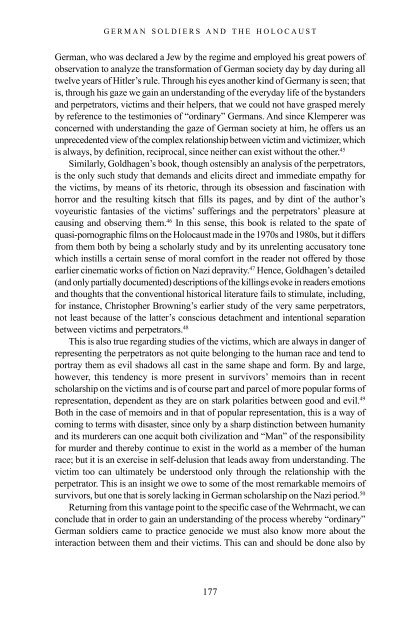The_Holokaust_-_origins,_implementation,_aftermath
The_Holokaust_-_origins,_implementation,_aftermath
The_Holokaust_-_origins,_implementation,_aftermath
Create successful ePaper yourself
Turn your PDF publications into a flip-book with our unique Google optimized e-Paper software.
GERMAN SOLDIERS AND THE HOLOCAUST<br />
German, who was declared a Jew by the regime and employed his great powers of<br />
observation to analyze the transformation of German society day by day during all<br />
twelve years of Hitler’s rule. Through his eyes another kind of Germany is seen; that<br />
is, through his gaze we gain an understanding of the everyday life of the bystanders<br />
and perpetrators, victims and their helpers, that we could not have grasped merely<br />
by reference to the testimonies of “ordinary” Germans. And since Klemperer was<br />
concerned with understanding the gaze of German society at him, he offers us an<br />
unprecedented view of the complex relationship between victim and victimizer, which<br />
is always, by definition, reciprocal, since neither can exist without the other. 45<br />
Similarly, Goldhagen’s book, though ostensibly an analysis of the perpetrators,<br />
is the only such study that demands and elicits direct and immediate empathy for<br />
the victims, by means of its rhetoric, through its obsession and fascination with<br />
horror and the resulting kitsch that fills its pages, and by dint of the author’s<br />
voyeuristic fantasies of the victims’ sufferings and the perpetrators’ pleasure at<br />
causing and observing them. 46 In this sense, this book is related to the spate of<br />
quasi-pornographic films on the Holocaust made in the 1970s and 1980s, but it differs<br />
from them both by being a scholarly study and by its unrelenting accusatory tone<br />
which instills a certain sense of moral comfort in the reader not offered by those<br />
earlier cinematic works of fiction on Nazi depravity. 47 Hence, Goldhagen’s detailed<br />
(and only partially documented) descriptions of the killings evoke in readers emotions<br />
and thoughts that the conventional historical literature fails to stimulate, including,<br />
for instance, Christopher Browning’s earlier study of the very same perpetrators,<br />
not least because of the latter’s conscious detachment and intentional separation<br />
between victims and perpetrators. 48<br />
This is also true regarding studies of the victims, which are always in danger of<br />
representing the perpetrators as not quite belonging to the human race and tend to<br />
portray them as evil shadows all cast in the same shape and form. By and large,<br />
however, this tendency is more present in survivors’ memoirs than in recent<br />
scholarship on the victims and is of course part and parcel of more popular forms of<br />
representation, dependent as they are on stark polarities between good and evil. 49<br />
Both in the case of memoirs and in that of popular representation, this is a way of<br />
coming to terms with disaster, since only by a sharp distinction between humanity<br />
and its murderers can one acquit both civilization and “Man” of the responsibility<br />
for murder and thereby continue to exist in the world as a member of the human<br />
race; but it is an exercise in self-delusion that leads away from understanding. <strong>The</strong><br />
victim too can ultimately be understood only through the relationship with the<br />
perpetrator. This is an insight we owe to some of the most remarkable memoirs of<br />
survivors, but one that is sorely lacking in German scholarship on the Nazi period. 50<br />
Returning from this vantage point to the specific case of the Wehrmacht, we can<br />
conclude that in order to gain an understanding of the process whereby “ordinary”<br />
German soldiers came to practice genocide we must also know more about the<br />
interaction between them and their victims. This can and should be done also by<br />
177



